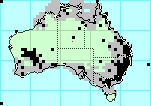
Podacanthus wilkinsoni,
nymph
By Peter Miller
 Podacanthus wilkinsoni, nymph |
Of course, as a field guide, it leaves a little to be desired, because the Internet is particularly hard to reach while in the field, desktop computers are usually impractical in the field, and even when using this web as a CD-Rom on a laptop, it weighs far too much.
It is my intention, once the research is complete, is to publish this information as book, if this is economically feasible. By making the information available as a web site, it is available earlier and it may be reviewed and critiqued and improved long before it reaches print.
The stick insects are presented in scientific taxonomic order, as is usual for field guides, but unless you are simply browsing, I suggest you use one of the indexes or keys to find what you are looking for.
This is the subject of ongoing research, and will improve over time. Don't expect too much at this stage.
 The distribution map is the collation of all of the distribution maps
for each species. It is possible to obtain lists of species by location,
just by clicking on the 1° square if interest, which may also assist
in identification. (Or provide ``twitcher'' lists for field trips.)
Within the species list, just click on the species name and you will be
taken directly to the species details.
The distribution map is the collation of all of the distribution maps
for each species. It is possible to obtain lists of species by location,
just by clicking on the 1° square if interest, which may also assist
in identification. (Or provide ``twitcher'' lists for field trips.)
Within the species list, just click on the species name and you will be
taken directly to the species details.
This is the subject of ongoing research, and will improve over time. Don't expect too much at this stage.
There is also brief taxonomic outline available for scientists. It isn't especially meaningful to the layman. Just click on the species name, genus name, subfamily name, or family name and you will be taken directly to the relevant details. Researchers may also be interested in the synonym index.
 Bibliography
BibliographyThe pages describing each species, genus, subfamily and family also include a References section. Where a paper has provided information for a web page, it will be linked so that you may pursue the relevant literature. It will usually be linked to an abstract of the paper.
The ProjectA description of the project behind this set of web pages. What it is, why it's being done, and what it would like to be when it grows up.There is also a What's New page. Please come back every few months to see what has improved since your last visit. Export RegulationsSorry. I can't send stick insect eggs overseas. Please don't ask. |
Groups and OrganisationsDescriptions of Australian groups interested, directly or indirectly, in Stick Insects.Links to the web sites of other groups and institutions and people around the world.
Peter Miller is an amateur stick insect collector and breeder,
interested in Australian stick insects since 1994.
|
|
Copyright © 2000-2003
Peter Miller
This page was last changed 20-Sep-2006. |

|

|